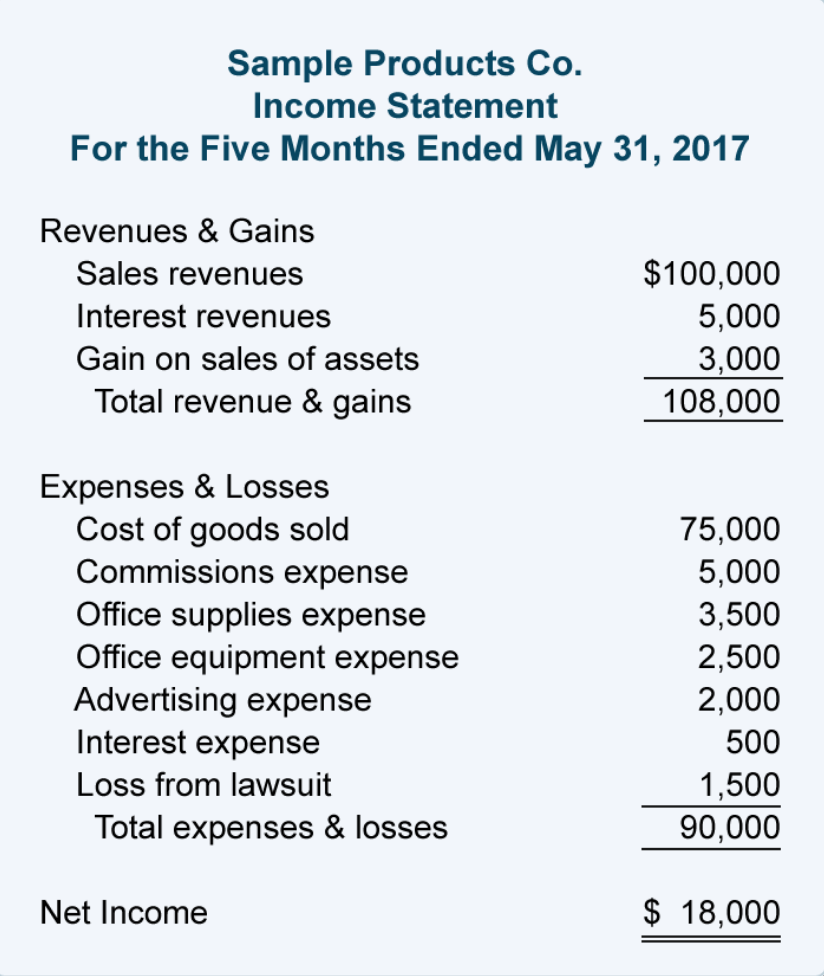An income statement can be defined as a financial document which a company prepares that describes its business and financial activities over a certain period.
The preparation of the income statement of companies differs from company to company. Each company might decide to use whichever of the two popular methods that suit them according to the laws of their country,
Hence, for the sake of this article, we’d streamline the methods of income statements to one – Single Step Income Statement.
We’d discuss its meaning, the differences between it and the Multi-step income statement, its examples, formats and how to calculate income tax expense in single step income statement.
Single Step Income Statement
The Single Step Income Statement, also known as one step statement can be defined as a method of preparing an income statement where the net incomes, revenues, and expenses are grouped differently without further breakdown.
It is usually done in this manner for simplicity’s sake. And makes record keeping easier for investors who read them and the accountants who prepare them.
Private companies use the single-step income statement method to prevent external people from having access to their full financial activities.
It is also used by sole proprietorships, simple-partnerships, and other small, service-based businesses. Public companies on the other hand mostly make use of Multi-step income statements.
By merely looking at an income statement prepared with this method, one with no previous financial experience or knowledge can easily decipher if the company made profit or loss but won’t have the details.
And this is why it is used by most companies, as it offers a very straightforward account of your business’s financial activity.
Conversely, though the single-step income statement lacks detail, it is easy to prepare and easy to analyze. That is why it is most often used for internal purposes.
The management of a company might decide to prepare single-step income statements for single departments within the company as well as company divisions.
In addition, make use of this data to analyze the performance of the department during a period, set budget goals, and prepare for the next period.
In general, some companies may decide to use a combination of single and multi-step income statements for their internal use. This method is slightly more detailed than the single step income statement but not as detailed as a multi-step income statement.
There is a simple formula used in single step income statement and it is stated thus:
Net Income = (Revenues + Gains) – (Expenses + Losses)
We will discuss this further in the formats of single step income statement below.
READ ALSO: Risk Analysis: Methods, Types, Process, Examples, Pros & Cons
Single Step Income Statement Vs. Multi-Step Income Statement
Both the Single step income statement and Multi step income statement are two viable methods used by most companies in preparing their income statement. Hence, to know the difference between the two, we have to first define the Multi-step income statement.
A multi-step income statement is an income statement preparation method where the same information represented on the single-step income statements is included and more detailed. It is like a broken down version of the single-step income statements.
This method provides an in-depth look at the company’s financial activities as it offers details about the company’s wellbeing.
In a Multi-step income statement, the various expenses are grouped into operational expenses or non-operational expenses.
This means that they are grouped to show whether they are expenses for a particular product or service or expenses that were made for the collective infrastructural development of the company and can therefore not be assigned to the cost of a specific product or service.
The multi-step income statement method makes use of three different formulas:
- Gross Profits = Net Sales – Cost of goods sold
- Operating Income = Gross Profit – Operating expenses
- Net Income = Operating Income + Non-Operating Income.
Asides from the differences seen from the definition of the income statement methods, another major difference is that the single-step income statement is easy to prepare and very easy to read while the multi-step income statement is labor-intensive and could become overwhelming for some possible investors or creditors to sort through.
READ ALSO: How To Calculate Average Inventory- A complete Step-by-Step Guide
Example of Single-step income statement
Below is what a typical Single step income statement would look like.

Looking at this example above it shows us that the Single step income statement is divided into two categories, the revenue category and the expense part.
This also shows how the large sums are just stated and no further details are given. We must also take note of the items contained in each of the categories and make sure they are all always recorded accurately.
Single Step Income Statement Format
The format for this method is as simple as the method itself. Here is how to prepare a single step income statement format.
#1. State the period for which the income statement is being reported
This is the very first thing to do when creating a single step income statement. It helps to make things easier for whoever is going to make use of the document you’re preparing.
Businesses that make use of this method are free to choose to prepare income statements on either a monthly, quarterly or yearly basis, depending on their preference.
Seeing that they are small businesses, the release of their financial statements is not regulated by the law, but it is still advised to prepare and release financial statements quarterly.
However, this is not the case for corporations. They are required by law to release their financial statements quarterly and annually.
READ ALSO: Strategic Alliance: Types & Examples in 2021
#2. Include a Heading
Single step income statements usually includes a heading at the beginning. This heading contains and conveys vital information such as the name of the company.
It also makes it known that this document is an income statement and contains the period for which the income statement is being reported.
#3. Sum the Revenues
The next step is to create the first part of the income statement which is the revenues category. It is usually at the top of the report, while the expenses part is below.
Input in lines, the revenues sources that your business has to report for that period and then sum them up to determine the revenue subtotal. The number that is gotten will then be put into the Total Revenues line at the bottom of the Revenues category of the income statement.
#4. Sum the Expenses
The second part of the single step income statement is the expenses. This is directly below the revenues category. Input every expense that your business has to report in lines.
After this, sum them up to get the expense subtotal and input the figure in the line of the Total Expense at the bottom of the expense part.
#5. Calculate the Net Income
To determine the Net Income of your business, you subtract the value of the Total Expenses from the value of the Total Revenues.
If the resulting value of the Net Income is a positive number, then your business is reporting a profit for this reporting period but if the resulting value of the net Income is a negative value, your business is reporting a loss for that reporting period.
READ ALSO: Inbound Marketing: Effective Inbound Marketing Examples
Calculating Income Tax Expense in Single Step Income Statement
Income tax is a statutory tax on the profits generated by an organization or a person in an accounting year. This is considered as a liability and an expense because the payment of this tax results in an outflow of cash from the organization or person.
The standard formula for the calculation of Income Tax Expense is given as:
Income tax expense formula = Taxable Income * Tax Rate
NB: Income tax is gotten from showing only the tax expenses that occurred during a certain period and not during the period when they were paid.
The taxable income of the organization or individual is to be determined. This process is quite complicated since there are various ways various sources are taxed.
For instance, a company has to pay one kind of tax on the salaries it pays to its employees, then another tax on the purchase of any assets. Furthermore, there are taxes levied at the state or the national level as well.
Hence, the correct tax rate to be determined at this will ultimately affect the income tax expense to be borne by the company. It can be done with the help of accounting standards like Generally Accepted Accounting Principles (GAAP) and International Financial Reporting Standard (IFRS).
Things to Note About the Income Tax Expense
Below are a few things to note about the income tax expense;
#1. The difference between Financial Accounting and Tax Code
Sometimes, the reported income by companies on their income statements differs from the taxable income as determined by the tax code. And this depends on the accounting standards given by GAAP and IFRS.
One of the reasons this may be happening is that according to the tax code, companies are supposed to use the accelerated depreciation method to determine their taxable profit.
While according to accounting standards companies are supposed to use the straight line depreciation method to determine depreciation for that accounting year.
This difference brings about a mismatch between the income tax expense and the tax bill.
READ ALSO: Long Put: The Complete Beginners’ Guide (+Quick Tools)
#2. Minimizing Taxable Income
As we’ve earleir discussed, income tax involves an outflow of cash and is hence considered a liability for the organization.
Income tax expense is paid out of the profits the organization makes. This means that if the organization didn’t have to pay taxes, this money would serve as profit and used for other purposes like distribution amongst the stockholders.
Thus, organizations have to be careful and minimize their taxable incomes if not, they would end up spending from their profits. And this would, in turn, reduce the profits supposed to be used for other purposes.
#3. Losses and Taxable Income
Income tax is levied on taxable income only. This means that if a company is making losses, it possibly has zero taxable income.
Which in turn means that there is no tax expense recorded in the single step income statement. The organization can carry its losses forward to the coming years and in some cases even end up cancelling out the future tax liability.
READ ALSO: What is Outbound Marketing Strategy? Examples & Tools
What Is the Importance of the Single Step Income Statement?
The single-step structure has the unmistakable benefit of being simple to prepare. Its emphasis on net income is also very helpful when a user is evaluating anything that depends on net income, or the bottom line.
Who Uses Single Step Income Statement?
The single-step format, which is simpler to prepare, may be used by sole proprietorships, partnerships, and other small enterprises.
What Is a Multiple Step Income Statement?
A multi-step income statement is a financial statement for a business that displays revenues, expenditures, and expenses for a certain reporting period.
What Is the Difference Between a Single Step and Multistep Income Statement?
A one-step income statement concentrates on disclosing the company’s net income through a single calculation. A multi-step income statement is more in-depth and uses several computations as well as an itemized breakdown to determine the gross profit and operating income of the company.
How Do Accountants and Investors Benefit from Single Step Income Statements?
A single-step income statement provides a quick, simple way to see how well a business is doing financially. Investors and accountants can easily see all of the gains and losses. A shareholder can easily assess the company’s financial performance by focusing on the net income.
What Is a Single Step Process?
any form of additive manufacturing when the part is made using a single process and has the desired shape and material attributes
What Is the Example of Multi-Step?
Multiple operations, such as subtraction, addition, multiplication, division, or exponentiation, are needed to solve multi-step equations in algebra. When attempting to solve multi-step equations, it is crucial to understand the order of operations.
Bottom Line
As a small business owner, using a single-step income statement can limit your ability to get a loan or possible investors. This is because, potential investors may find the single-step income statement too scanty, or lacking information.
The absence of data on gross margin and operating margin can pose a difficulty in finding the source of most expenses and can make it harder to project whether your company would sustain profitability.
Hence, using multi-step income statements becomes the better alternative. Because it allows for deeper analysis of margins and provides more accurate representations of the cost of goods sold.
Such detail gives possible investors or creditors a better view of how your company runs its business.
Regardless, one has to be very careful when preparing the multi-step income statement as any wrong categorization of the revenue and expense could lead to bad consequences.
FAQs
What is the EPS formula?
Earnings per share (EPS) is calculated as a company’s profit divided by the outstanding shares of its common stock. The resulting number serves as an indicator of a company’s profitability.
What is basic EPS?
Basic earnings per share (EPS) tells investors how much of a firm’s net income was allotted to each share of common stock. It is reported in a company’s income statement and is especially informative for businesses with only common stock in their capital structures. 0 seconds of 0 seconds. Live.
What is BV per share?
Book value per share (BVPS) is the ratio of equity available to common shareholders divided by the number of outstanding shares. This figure represents the minimum value of a company’s equity and measures the book value of a firm on a per-share basis.






